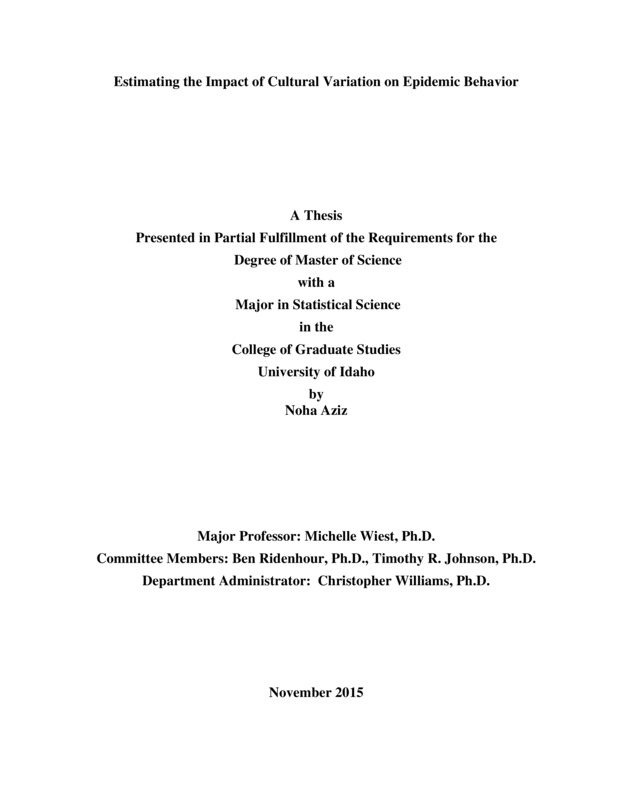ESTIMATING THE IMPACT OF CULTURAL VARIATION ON EPIDEMIC BEHAVIOR
Aziz, Noha. (2015). ESTIMATING THE IMPACT OF CULTURAL VARIATION ON EPIDEMIC BEHAVIOR. Theses and Dissertations Collection, University of Idaho Library Digital Collections. https://www.lib.uidaho.edu/digital/etd/items/aziz_idaho_0089n_10776.html
- Title:
- ESTIMATING THE IMPACT OF CULTURAL VARIATION ON EPIDEMIC BEHAVIOR
- Author:
- Aziz, Noha
- Date:
- 2015
- Embargo Remove Date:
- 2016-12-15
- Program:
- Statistical Sciences
- Subject Category:
- Statistics
- Abstract:
-
Ebola was discovered in 1976 (WHO, 2015). It has killed many people throughout history, but the 2014 West Africa epidemic was an apocalypse-sized outbreak. This epidemic would have harvested lives five times more than the lives that all known Ebola epidemic has harvested combined (BBC, 2015).
At a basic level, the success of interventions depends on behavioral responses to disease conditions, as well as risk perception and cultural norms that might conflict with interventions. Such sociological conditions can be very fluid, influenced by circumstances on the ground as well as the evolution of opinions within the community.
Sierra Leone, Liberia and Guinea have a unique combination of geographic, sociocultural and political factors (Walker & Whitty, 2015). Those factors combined together in one region formed an ideal environment for the epidemic to explode. The absence of accurate critical data did not help to understand the dynamics of the epidemic and created a hazed and unclear picture of the situation and the conditions that helped the Ebola outbreak to evolve. Unfortunately, most models of emerging epidemics do not account for cultural variation which impacts the case incidence within and across affected countries.
This thesis begins to the fill the gap in understanding how sociocultural characteristics can affect the dynamics of an emerging infectious disease. To accomplish this, we focused on Liberia as a case study. We evaluated the association of social and cultural variables and actual case counts by using principle component analysis (PCA), autoregressive integrated moving average (ARIMA) model and cross correlation between the counties to explore the relationship between those factors and the epidemic.
- Description:
- masters, M.S., Statistical Sciences -- University of Idaho - College of Graduate Studies, 2015
- Major Professor:
- Wiest, Michelle
- Committee:
- Ridenhour, Ben; Johnson, Timothy
- Defense Date:
- 2015
- Identifier:
- Aziz_idaho_0089N_10776
- Type:
- Text
- Format Original:
- Format:
- application/pdf
- Rights:
- In Copyright - Educational Use Permitted. For more information, please contact University of Idaho Library Special Collections and Archives Department at libspec@uidaho.edu.
- Standardized Rights:
- http://rightsstatements.org/vocab/InC-EDU/1.0/

